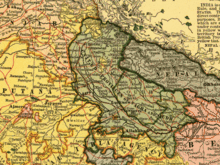Avadh
Avadh (also Awadh ; Devanagari : अवध, avadha; ; Urdu اودھ; in British India officially Oudh , also known as Oundh or Oude ) is an extremely fertile region in northern India and takes up about a third of the state of Uttar Pradesh . In this region there was a princely state with the capital Lucknow until 1856 , which is still the capital of Uttar Pradesh today. This region has its own dialect of Hindustani called Avadhi . The name "Avadh" did not appear until the 15th century.
history
In the 1st millennium BC The kingdom of Kosala with the capital Ayodhya existed here . At the time of the Buddha (around 500 BC) the city of Shravasti also played an important economic and political role. Already at the time of the Sultanate of Delhi (1206-1526) the Sultanate of Jaunpur , which was ruled from 1394 to 1479 by the Sharqi dynasty , was able to expand its sphere of influence over parts of Avadh. In the First Battle of Panipat (1526) the Mughals conquered the north of India, the outskirts of which (as already practiced before) were administered by governors ( subahdars ) .
Mughal Empire
Under the Mughal Mughal Akbar, Avadh was raised to the rank of a province ( subah ) at the end of the 16th century . In 1722, Saadat Khan was appointed Nawab and initially resided in Faizabad . He took advantage of the increasing weakness of the Mughal Empire to found his own dynasty. The second Nawab of Oudh was his nephew and son-in-law Safdarjung (r. 1739–1754), who had the last significant tomb of the Mughal era built in Delhi .
Due to the dwindling importance of Delhi, Avadh became an important center for art, literature and religious life in northern India. The Nawabs, who were Persian Shiites, distinguished themselves as promoters of cultural life. During this period, Urdu became increasingly important as the everyday language, although Persian was still the predominant language for most official occasions.
Avadh was considered the "breadbasket of India" and also had an important strategic position in the Doab , the fertile plain between the Ganges and Yamuna rivers . It was big and rich enough to maintain its independence from the Marathas and Afghans in the second half of the 18th century . Under the third nawab, Shuja-ud-Daula , a conflict arose with the British when he gave assistance to the fugitive Bengali nawab , Mir Qasim . In the Battle of Buxar his 40,000-strong army was decisively defeated by the troops of the British East India Company , which had a strength of only 7,072 men, and the Nawab had to cede parts of its territory and pay heavy fines. In 1773 a British resident was appointed to oversee the princely state and to arrange the stationing of British troops and the assumption of the costs for them. The East India Company refrained from direct annexation because at this point it did not want any conflict with the Marathas and the remnants of the Mughal empire, and was moreover reluctant at this stage to have overly extensive areas under costly sovereign administration.
In the years 1773 to 1774 the Nawab led the Rohilla War with British help , as a result of which he annexed Rohilkhand . In 1798 the fifth nawab, Wazir Ali Shah , made himself unpopular with both his people and the British and was forced to resign by Governor General John Shore . The British installed Saadat Ali Khan as a puppet ruler, who ceded half his territory to them and also disbanded his troops in favor of a very expensive, British-led professional army. This effectively made Avadh a British protective state, albeit under the theoretical sovereignty of the Mughal emperor.
British sovereignty
This contract, concluded with Saadat Ali Khan in 1801, brought in a great deal for the East India Company, especially since it repeatedly accessed state revenue for cheaper credits. To the west, Avadh acted as a buffer state. The Nawabs degenerated into symbolic figures who surrounded themselves with great pomp but had little influence on state affairs. However, the British became increasingly dissatisfied with this situation in the middle of the 19th century and wanted to bring the area under direct control. The extravagant and extremely expensive lifestyle of the Nawabs provided an excuse for this.
In 1856 Avadh was annexed and placed under a chief commissioner . The area became a British province under the administration of James Outram and Henry Lawrence . They carried out reforms that limited the power of the large landowners. Nawab Wajid Ali Shah was arrested and exiled to Calcutta . This was a decisive trigger for the uprising of 1857 , in which the troops stationed in Avadh played a key role. It took the British eighteen months to retake Avadh and the most extravagant atrocities such as the Kanpur massacre were committed in the area .
After the rebellion was put down, the leaders of the uprising fled to Nepal . Among them was the fourteen-year-old Birjis Qadr, son of the last nawab. Oudh (as the British now officially called it) became a province of what was now the Empire of India. In 1877 the function of governor of the Northwest Province of Agra was merged with that of the Chief Commissioner of Oudh, and in 1902 the two provinces were also formally amalgamated under the name United Provinces of Agra and Oudh . The present state of Uttar Pradesh emerged from these United Provinces .
See also
- The former Bundelkhand region bordered south of Avadh .
Web links
Individual evidence
- ^ Sir Edward Cust: Annals of the Wars of the Eighteenth Century: Compiled from the Most Authentic Histories of the Period . tape 3 . Mitchell's military library, 1858, ISBN 1-235-66392-2 , pp. 113 (English, limited preview in Google Book Search [accessed December 23, 2016]).


